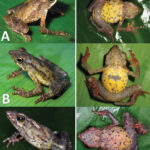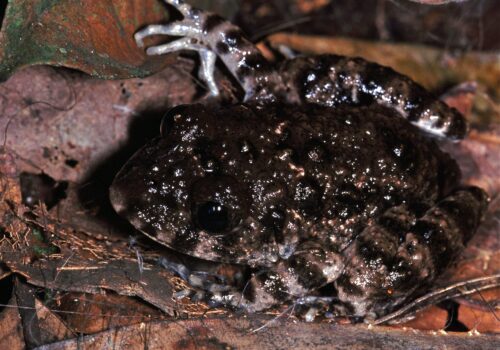- Golden Beauty in the Leaf Litter: Exploring the Fascinating World of Arthroleptis aureoli
- Taxonomy and Classification
- Natural Habitat: The Realm Beneath the Canopy
- Physical Characteristics: Nature's Subtle Masterpiece
- Behavior and Life Cycle: A Unique Terrestrial Development
- Ecological Role: Guardians of the Forest Floor
- Threats and Conservation Status
- Cultural and Scientific Significance
- Conclusion: Securing a Silent Guardian's Future
Golden Beauty in the Leaf Litter: Exploring the Fascinating World of Arthroleptis aureoli#
Deep amidst the lush, verdant foliage of West Africa’s tropical forests, a tiny amphibian moves silently beneath the canopy shadows, masterfully blending into its surroundings. This inconspicuous creature, none other than Arthroleptis aureoli—the Freetown long-fingered frog—may escape human notice at first glance, hidden as it is in the thick tapestry of leaf litter, moss-covered stones, and subtle earth tones. Yet behind its modest exterior lies a story of ecological importance, evolutionary adaptation, and pressing conservation concerns.
With its scientific name Arthroleptis aureoli given due homage, this delicate amphibian bears significance beyond its minute stature or humble camouflage. It serves as an environmental sentinel, signaling the ecological health of West Africa’s vulnerable rainforests. Before diving deeper into its cryptic world, there’s one curious fact that immediately commands attention: this species bypasses the conventional amphibian lifecycle entirely by hatching directly into miniature froglets, skipping the aquatic tadpole stage—a marvel of evolutionary divergence!
Taxonomy and Classification#
Scientifically known as Arthroleptis aureoli, this diminutive species belongs proudly within the genus Arthroleptis. This genus is situated in the family Arthroleptidae, renowned among amphibian scientists for including species exhibiting direct terrestrial development. The family itself encompasses a variety of small-bodied, cryptically colored frogs adapted specifically for living their lives intimately tied to forest floors and leaf litter.
Although the genus Arthroleptis harbors numerous species, Arthroleptis aureoli stands out—an inhabitant specifically geographically linked to Sierra Leone and contiguous parts of neighboring West African nations. Its closest relatives in the genus similarly occupy leaf litter habitats, also sharing specialized morphological adaptations attuned to a terrestrial lifestyle.
Natural Habitat: The Realm Beneath the Canopy#
A Delicate Mosaic of Biodiversity#
The geographic range of Arthroleptis aureoli primarily spans Sierra Leone and surrounding regions such as Liberia. Here, dense rainforest terrains and forest-savanna mosaic habitats form ideal ecosystems, characterized by humid conditions, persistent humidity, and stable temperatures—a paradise for small, moisture-loving creatures.
Unlike typical frogs dependent on open waterways or ponds, Arthroleptis aureoli lives exclusively in the richly layered leaf litter blanketing forest floors. Beneath towering tropical trees draped in moss and vines, sunlight penetrates sparsely, creating dim yet cozy humidity specifically suited to their delicate physiology. Decaying organic material carpets their ground-bound realm—a vibrant microcosm teeming with insects, arthropods, and countless other tiny organisms interwoven into Arthroleptis’s daily existence.
Masters of Camouflage and Subtlety#
Adapted perfectly to forest litter life, Arthroleptis aureoli gracefully navigates dense tangles of roots and decomposing leaves in near-silence. Its color palette—muted tan, brownish-gold, olive, and earthy shades—camouflages it flawlessly amidst leaf-flecked floors peppered with fallen branches, fungi patches, and moss-covered stones.
This specialized habitat preference serves multiple purposes: protection from predators, plentiful food sources, and ideal conditions for reproduction without dependency on standing water—an unusual but advantageous evolutionary adaptation.
Physical Characteristics: Nature’s Subtle Masterpiece#
Small in size, rarely exceeding just 35mm in total length, Arthroleptis aureoli illustrates beauty in modesty. Their slender bodies, elongated legs, and long finger digits aid agile navigation through the intricate forest litter environment. A close observation reveals delicate golden-brown patterns interspersed with darker mottles, resembling sun-dappled leaves fallen on the forest floor—a sophisticated evolutionary disguise.
Their eyes are relatively large and dark, equipped to capture sparse sunlight penetrating through dense canopy foliage. Unlike tree frogs or brightly colored poisonous amphibians found elsewhere, Arthroleptis aureoli proudly showcases a coloring suited entirely to subtlety, evolved toward invisibility rather than conspicuous warning hues.
This camouflage shields these sensitive animals from vigilant predators—birds, snakes, and small mammals constantly seeking prey amid forest floor foliage. Thus, their coloration contributes significantly not just to individual survival but indirectly assures ecological success and reproduction.
Behavior and Life Cycle: A Unique Terrestrial Development#
Silent Predators of the Leafy Realm#
A fascinating aspect of Arthroleptis aureoli is their foraging behavior. Equipped with quick reflexes, they actively pursue and ambush ants, termites, small beetles, and other tiny arthropods abundant among decaying organic debris. A sudden spring towards prey—executed with surprising precision—captures food sources swiftly before retreating back into camouflage.
Extraordinary Breeding Habits: Without A Tadpole Stage#
Perhaps the most intriguing characteristic of Arthroleptis aureoli lies in its reproductive behavior and lifecycle—distinctly terrestrial from start to finish. Females deposit clusters of small eggs directly beneath moist leaves or rotting logs, bypassing ponds, streams, or standing water habitats. Here occurs a remarkable phenomenon: rather than emerging as tadpoles, hatchlings resemble tiny fully-formed froglets from birth.
This direct development represents a profound evolutionary innovation, enabling survival within strictly terrestrial environments. Thus, protected from threats present in aquatic ecosystems, young froglets emerge already equipped to navigate their forest floor terrain—a fascinating evolutionary adaptation strongly indicative of their unique ecological niche.
Ecological Role: Guardians of the Forest Floor#
Though diminutive, Arthroleptis aureoli bears significant ecological significance as both predator and prey within its realm. Feeding predominantly upon leaf-litter-dwelling insects and arthropods, they regulate populations of forest pests and decomposers, contributing crucially towards ecological balance.
In turn, their presence as potential prey supports predator species higher on the forest food web. Their delicate status also served as an indicator species; changes in local populations could signal broader ecosystem disruptions caused by pollutants, invasive species, or climate-related abnormalities.
Threats and Conservation Status#
A Fragile Existence in Peril#
Sadly, Arthroleptis aureoli shares threats common among amphibian species globally. Habitat loss through deforestation, expanding agriculture, logging, and urban development continuously reduces available habitat. Such fragmentation impairs local population connectivity, weakening genetic variability and resilience.
Additionally, threats such as climate change induce increasingly unpredictable rainfall patterns, temperatures fluctuations, and intensified drought periods—conditions severely disruptive to moisture-reliant leaf litter habitats.
Currently, the IUCN categorizes Arthroleptis aureoli as Near Threatened, highlighting urgent need for robust conservation measures and habitat preservation strategies intended to safeguard long-term population stability.
Cultural and Scientific Significance#
Although relatively unknown culturally compared to iconic amphibians featured prominently in myths or folklore, Arthroleptis aureoli garners increasing scientific attention. Researchers closely study their direct terrestrial development process, adaptive strategies amid habitat degradation, and sensitivity to environmental stressors. These fascinating traits grant scientists essential insights useful for ecological, evolutionary, and environmental research.
Through raising awareness, generating scientific interest, and injecting appreciation for these unique species into broader societal consciousness, Arthroleptis aureoli holds great potential as ambassadors symbolizing delicate rainforest ecosystems in urgent conservation need.
Conclusion: Securing a Silent Guardian’s Future#
Though small and seldom noticed, Arthroleptis aureoli silently symbolizes the astonishing complexity embedded throughout West Africa’s threatened rainforest habitats. Embracing appreciation for their captivating adaptations, biological marvels, and vital ecological roles must inevitably translate into protective measures benefitting countless species inhabiting such precious biodiverse landscapes.
As we deepen our collective understanding, admiration, and respect for these diminutive frogs and their fragile habitats, we extend a hopeful lifeline toward maintaining environmental integrity across West Africa—and, subsequently, our shared global ecosystem.
Join in celebrating, researching, supporting, or advocating for diverse conservation initiatives protecting remarkable creatures like Arthroleptis aureoli—a golden treasure hidden subtly amid leaf litter, awaiting careful discovery, protection, and stewardship.










